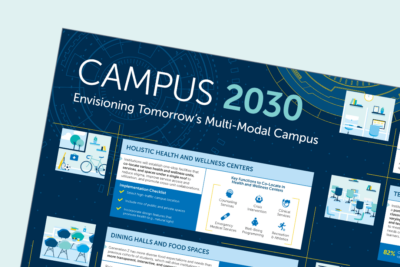Optimize Office Space on the Post-COVID-19 Campus
The top financial, policy, and design changes higher ed leaders are planning for workspaces
Liliana Loosbrock, Senior Research Analyst
As colleges and universities embrace hybrid workplaces, higher ed leaders are turning their attention to aligning office spaces with campus demand and staff needs.
In response to these ongoing efforts by universities to seek out short- and long-term plans for flexible work, EAB convened several groups of chief business officers and senior facilities officers to discuss their successes and challenges. During these sessions, we asked campus leaders to brainstorm and prioritize strategies for maximizing the value and utilization of campus office spaces. See below for the most popular financial, policy, and design changes your peers are exploring.
High-effort, high-impact financial investments to improve space management and utilization are popular
Across our sessions, senior leaders consistently expressed the most interest in financial strategies for improving office space utilization. We offered our small groups several examples of financial strategies to start our conversations.
Sample financial strategies
- Adjust university budget model to incentivize units to forfeit space that they do not need
- Invest in automated data-collecting technology (e.g., people counters, CO2 sensors, wi-fi trackers) to monitor office space utilization
- Implement a campus-wide space scheduling and booking system (and use to track utilization)
- Create an opt-in incentive program for faculty/staff to share workstations
- Offer to fund relocation costs for units that are willing to give up their current space and move to an alternative work location (e.g., off-campus space)
- End off-campus leases and replace with access to drop-in co-working space (e.g., WeWork)
The most popular strategies tend to fall into two categories: 1) investments that incent desired behavior among campus stakeholders and 2) investments that improve management and accountability.
To incent behavior among campus stakeholders, campus leaders have been most drawn to high-effort solutions like reworking their institution’s budget model to encourage units to forfeit underutilized space. To improve management and accountability, campus leaders are particularly excited about investing in automated data-collection technology (e.g., people counters, CO2 sensors, wi-fi trackers) that monitors office space utilization in real-time.
This technology is widely considered low-effort, high-impact due to the lowering costs of technology paired with the ability for Facilities units to implement the changes without other campus stakeholders buying into the concept.
Spotlight
The University of Alberta was wasting resources by deploying staff to clean underutilized spaces. Incorporating thermal “people sensors” that prioritize spaces in need of janitorial attention based on daily usage enabled the campus to deploy smarter space utilization and maintenance decisions.
For example, with better data about room usage, cleaning staff are now deployed based on need, allowing the freed-up staff capacity to be used on other semiannual or annual activities (e.g., stripping and waxing hallways). Ultimately, this enabled the university to stretch limited staff resources further while not reducing service outcomes to space occupants.
Changing space policy is an attractive strategy, but often requires high effort due to staff and faculty resistance
Whereas campus leaders are often attracted to financial strategies because of the high-impact potential, they are drawn to policy changes because they rarely have high upfront costs. Nevertheless, many leaders have learned that changing space policies requires more effort than anticipated due to the need for widespread campus buy-in. Moreover, the impact of policy changes largely hinges on campus adoption and enforcement, which leaders cannot directly control.
Sample policy changes
- Use centralized space management for some/all spaces (e.g., classrooms, meeting rooms)
- Update space policy to emphasize university ownership of all campus space (i.e., units do not own certain offices or spaces)
- Adjust space policy to state that hybrid staff/faculty will be assigned a shared workstation (i.e., they are not guaranteed a private office space)
- Update space policy to include stipulations for office-space utilization and review process
- Standardize the review process for unit requests for additional office/meeting space to require evidence of need and history of unit space utilization
- Establish an in-office rotation schedule for hybrid units to ensure consistent space sharing and use
As seen in our small-group sessions, the most popular policy changes instigate a shift away from private offices and towards shared workspaces. However, campus leaders have historically received pushback from hybrid staff and faculty in response to the possibility of losing their private offices. The success of a policy change such as shared workspaces relies on determining what desk-to-employee ratio will be right for your workforce. As institutions solidify their remote work policies and get feedback from campus stakeholders, we expect further experimentation with these ratios.
Spotlight
The University of California, Davis created a “calculator” that estimates shared-workspace needs. This tool helps units plan for how many desks they will need in their office space based on overall headcount and hybrid work arrangements (e.g., onsite >60%, onsite 20-60%, onsite <60%).
Leaders agree design changes can boost space utilization, but have mixed views on the effort-impact tradeoff
While campus leaders have tended to prioritize financial and policy strategies to improve space utilization, there is growing interest in how design can also shape use. Moreover, leaders recognize that design changes, especially following the pandemic, can have the added benefit of increased employee satisfaction and productivity.
Sample design changes
- Renovate/build more shared workstations (e.g.,hoteling, hot-desking spaces)
- Reduce the number of private offices on campus (e.g., repurpose as bookable huddle rooms)
- Use flexible design features (e.g., modular partitions, universal grid floorplan) in administrative office spaces to maximize versatility
- Swap out office furnishings to increase density and compatibility with hybrid work
- Prioritize investments in multi-purpose spaces (e.g., collaborative workspaces, meeting rooms) that could be used by multiple stakeholder groups (e.g., faculty, staff, students, community members, industry partners)
In our sessions, campus leaders were most interested in renovating or building more shared workstations as well as prioritizing investments in multi-purpose spaces that can be used by multiple stakeholder groups. Both of these strategies encourage efficient space usage by promoting more mixed-use workspaces on campus while eliminating underutilized spaces reserved for select stakeholders. Leaders have voiced that the effort required for design changes depends on the scale and scope of the project along with how many of these spaces exist at a given institution.
Spotlight
The University of California, San Diego accommodates a range of workplace activities by designing office “neighborhoods” with four types of space: learn, collaborate, socialize, and focus. This flexibility allows staff to easily move between workspaces as their activities change and build connections with other colleagues who are similarly rotating between different “neighborhoods.”
UCSD accommodates a range of workplace activities by designing office “neighborhoods” with four types of space1

1. Floorplan for illustrative purposes only.
Explore the full list of ideas to optimize office space that EAB brainstormed and discussed with campus leaders.
More Resources

Space Productivity Metrics Toolkit

Campus 2030: Envisioning tomorrow’s multi-modal campus
